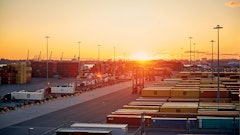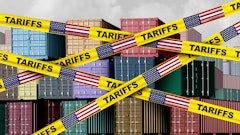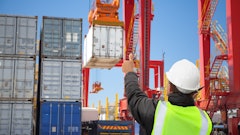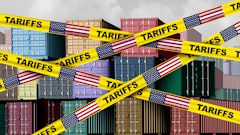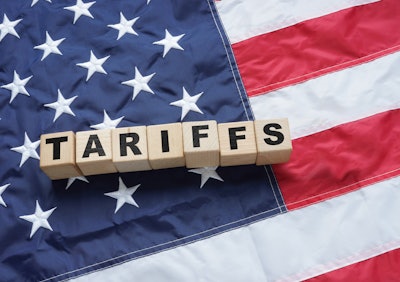
In recent months, sweeping tariff changes affecting more than 180 countries have sent shockwaves through global supply chains. Both business leaders and consumers are experiencing increased costs and delays in logistics operations. With logistics operations under mounting pressure, it’s more important than ever for organizations to monitor policy updates and tailor strategies that mitigate disruption. The challenge is significant and may require ongoing adjustments.
While tariffs create broad challenges, logistics leaders must understand how different transportation methods will be affected. Here’s a breakdown of the potential implications across five key logistics operations, and what to watch in terms of contractual obligations and market shifts.
1. Ocean freight: Trouble on the horizon for minimum commitments
In the past, ocean freight contracts rarely included exclusivity or volume minimums. Today, that's changing. Some container shipping contracts include minimum quantity commitments, which could pose challenges if tariffs affect demand. If these minimums aren't met, shippers may face financial penalties as outlined in standard shipping contracts or may need to renegotiate. Leaders should proactively review their contracts, particularly Force Majeure clauses, with legal teams.
Tariff changes may also prompt carriers to shift capacity to different routes. For example, historical data shows that U.S. tariffs have previously led to shifts in shipping routes, resulting in rate fluctuations. During the 2018 U.S.-China trade dispute, the U.S. imposed tariffs on Chinese imports, prompting retaliatory measures from China. This led to a surge in ocean freight rates, with spot rates from China to the U.S. West Coast increasing by over 70%, from $1,503 per 40-foot equivalent unit (FEU) in January 2018 to $2,604 per FEU in November 2018. Companies with high tonnage in these areas are advised to monitor changes closely and remain agile to avoid costly surprises.
2. Air freight: A high-cost mode under new pressure
Air freight doesn’t typically involve minimum quantity commitments, but it’s already a costly mode of transport, and new tariffs could further raise rates in the short term and reduce demand in the longer term.
One development to watch closely: the U.S. de minimis exemption, which waives duties on imports under $800. This rule has enabled certain companies to air-ship goods directly from China to U.S. consumers. If that exemption is removed—a move tied to current tariff talks—it may reshape global e-commerce and international shipping strategies.
3. Road freight: Domestic shifts on both sides of the Atlantic
Road freight may escape major contractual changes, but its demand profile could shift dramatically.
In North America, historical trends show that tariffs affecting cross-border trade often lead to increased tender rejections—when carriers decline contracted loads—pushing suppliers into the spot market or secondary carriers. These tariffs result in higher customs duties and operational expenses for trucking companies. For instance, the price of a new truck in the U.S. is projected to increase by approximately 9%, adding up to $35,000 per vehicle. Additionally, rising fuel prices, another consequence of tariffs, could lead to higher fuel surcharges. Reduced cross-border trade flows may redirect trucks into domestic markets across the United States, Canada, and Mexico, impacting freight capacity and rates.
In Europe, decreased exports to the United States could reduce road freight demand, slowing current price increases. For companies with strong road transport dependencies, this might bring short-term planning advantages and an opportunity to rebalance operations.
4. Warehousing: Inflation escalators and underused space
Most U.S. warehouse contracts include multi-year commitments with CPI- and PPI-based escalation clauses. Tariff-driven interest rate hikes could trigger cost increases through these built-in escalators.
However, a potentially bigger issue is warehouse utilization. If imports drop, demand for warehouse space may soften, as indicated by market trends, putting downward pressure on pricing. Logistics leaders must prepare for multiple scenarios, especially around inventory storage and contract renegotiations.
5. AI-powered supply chains: The best defense is visibility
Suppliers utilizing AI-enabled supply chains can adapt more quickly and efficiently to changes in logistics. Advanced technology and real-time data orchestration give businesses clearer visibility into risks, contract impacts, and cost structures.
This isn’t about the future—AI is already transforming logistics in various ways. Leaders leveraging intelligent solutions, as evidenced by recent case studies, can improve resource allocation and build resilience.
Final thoughts: Resilience over reaction
Whether the impact of new tariffs is minor or massive, the businesses that come out ahead will be those that plan, track, and adapt. Waiting to see how it all plays out simply isn’t a strategy.
Now is the time for logistics leaders to build playbooks for multiple scenarios, closely monitor policy and pricing shifts, and strengthen operational flexibility. The next few months will test the global logistics community and reward those ready to respond in real time.









